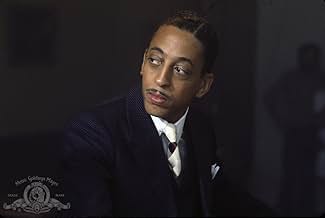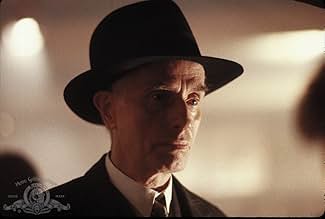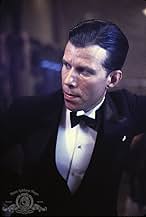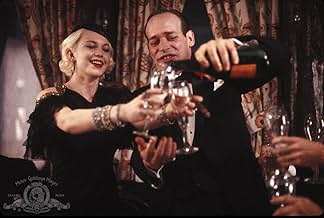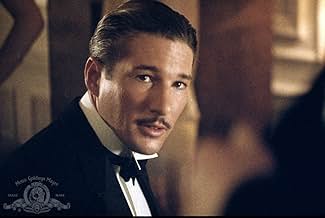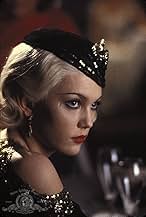CALIFICACIÓN DE IMDb
6.6/10
21 k
TU CALIFICACIÓN
Conoce a los músicos de jazz, bailarines, propietarios e invitados del Cotton Club en el Harlem de 1928 a 1930.Conoce a los músicos de jazz, bailarines, propietarios e invitados del Cotton Club en el Harlem de 1928 a 1930.Conoce a los músicos de jazz, bailarines, propietarios e invitados del Cotton Club en el Harlem de 1928 a 1930.
- Dirección
- Guionistas
- Elenco
- Nominado a 2 premios Óscar
- 1 premio ganado y 9 nominaciones en total
Laurence Fishburne
- Bumpy Rhodes
- (as Larry Fishburne)
John P. Ryan
- Joe Flynn
- (as John Ryan)
Opiniones destacadas
One gets the sense that 'The Cotton Club (1984)' will improve upon repeat viewings, once you've become accustomed to what director Francis Ford Coppola was attempting. After all, this is a gangster film from the man who brought us 'The Godfather (1972)' and its sequels – what else could we expect but another Corleone saga? The film we're delivered is nothing of the sort, a testament to the director's constant willingness to take risks and experiment with new ideas. Indeed, rather than trying to emulate Coppola's former successes, 'The Cotton Club' could more accurately be described as a "gangster musical," a realisation that took me until the film's second half. Do those two genres even go together? Perhaps taking inspiration from Herbert Ross' 'Pennies from Heaven (1981)' – and the mini-series on which it was based – the film blends the ugly brutality and corruption of the Prohibition- era with the dazzling bright lights of the Cotton Club, Harlem's premiere night club. It is this deliberate but uneasy juxtaposition of reality and fantasy that fuels Coppola's vision, an ambitious undertaking without a dominant focus.
The film's major storyline concerns Dixie Dwyer (Richard Gere), a comparatively ordinary jazz musician who unexpectedly finds himself associating with organised crime boss "Dutch" Schultz (James Remar). Dixie is interesting because, unlike your typical hero consumed by the allure of amoral riches, he always remains peripheral to the world of gangsters; he observes, with disapproval, its dishonesty and depravity, but rarely finds himself a part of it. In fact, the closest he ever comes to being a gangster is in Hollywood, where he shares the sort of film roles that made James Cagney and Edward G. Robinson famous. Coppola might have been offering a commentary on the inherently romanticised version of reality offered by the movies, but his "real world" of gangsters is scarcely less stylised. The seedy underbelly of organised crime is paradoxically depicted as taking place in the classiest locales in Harlem, where the crime bosses consume the best alcohol and mix with Hollywood's elite talent (Chaplin, Swanson and Cagney among the featured patrons).
Proving further that Coppola wasn't attempting to replicate his Corleone saga, 'The Cotton Club' also features a rather extraneous subplot with Maurice and Gregory Hines as African-American tap-dancers vying for the "big-time" at the Cotton Club, where (in a bizarre discriminatory switch) only black performers are hired. The regular cross-cutting between this story and Dixie Dwyer's doesn't quite work, and, in any case, the taut romance between Dwyer and tough-girl Vera (an absolutely gorgeous Diane Lane) is much more involving than that between Sandman Williams (Gregory Hines) and mixed-race dancer Lila (Lonette McKee). Among the film's impressive supporting performers are Bob Hoskins and Fred Gwynne as crime associates, Nicholas Cage as an overly-ambitious young thug, Laurence Fishburne as black crime boss Bumpy Rhodes, and James Remar, playing a sleazier and less identifiable version of Dutch Schultz to Dustin Hoffman in 'Billy Bathgate (1991).' The premiere gangster film of 1984 was Leone's 'Once Upon a Time in America (1984),' but, despite being runner-up, nobody can accuse Coppola of playing it safe.
The film's major storyline concerns Dixie Dwyer (Richard Gere), a comparatively ordinary jazz musician who unexpectedly finds himself associating with organised crime boss "Dutch" Schultz (James Remar). Dixie is interesting because, unlike your typical hero consumed by the allure of amoral riches, he always remains peripheral to the world of gangsters; he observes, with disapproval, its dishonesty and depravity, but rarely finds himself a part of it. In fact, the closest he ever comes to being a gangster is in Hollywood, where he shares the sort of film roles that made James Cagney and Edward G. Robinson famous. Coppola might have been offering a commentary on the inherently romanticised version of reality offered by the movies, but his "real world" of gangsters is scarcely less stylised. The seedy underbelly of organised crime is paradoxically depicted as taking place in the classiest locales in Harlem, where the crime bosses consume the best alcohol and mix with Hollywood's elite talent (Chaplin, Swanson and Cagney among the featured patrons).
Proving further that Coppola wasn't attempting to replicate his Corleone saga, 'The Cotton Club' also features a rather extraneous subplot with Maurice and Gregory Hines as African-American tap-dancers vying for the "big-time" at the Cotton Club, where (in a bizarre discriminatory switch) only black performers are hired. The regular cross-cutting between this story and Dixie Dwyer's doesn't quite work, and, in any case, the taut romance between Dwyer and tough-girl Vera (an absolutely gorgeous Diane Lane) is much more involving than that between Sandman Williams (Gregory Hines) and mixed-race dancer Lila (Lonette McKee). Among the film's impressive supporting performers are Bob Hoskins and Fred Gwynne as crime associates, Nicholas Cage as an overly-ambitious young thug, Laurence Fishburne as black crime boss Bumpy Rhodes, and James Remar, playing a sleazier and less identifiable version of Dutch Schultz to Dustin Hoffman in 'Billy Bathgate (1991).' The premiere gangster film of 1984 was Leone's 'Once Upon a Time in America (1984),' but, despite being runner-up, nobody can accuse Coppola of playing it safe.
Even Francis Ford Coppola couldn't sustain the height of movie-making he achieved in the 1970s. Raised too high by initial expectations, then dismissed too brusquely when the critics got to see it, "The Cotton Club" exists in a kind of neutral zone, a grand spectacle undone by sloppy scriptwriting and unappealing characters that nevertheless shows the master with some juice still in his cup.
It's the story of Dixie Dwyer (Richard Gere), a cornet player who one evening in 1928 almost accidentally saves the life of notorious mob boss Dutch Schultz (James Remar). Dutch, already a fan of his music, is appreciative of the extra service and brings Dwyer into his circle, which brings him into contact with Dutch's girl Vera (Diane Lane).
"If I didn't like you, you'd be dead," is Dutch's way of expressing friendship.
"It's nice to be liked," Dixie replies.
The film is centered around the nightclub of the title, a fashionable Harlem nightspot where blacks are welcome only on stage, entertaining the white customers. Owney Madden (Bob Hoskins) runs things with an eye for keeping order, especially where the volatile Dutchman is concerned. Sandman Williams (Gregory Hines) just wants to dance into the arms of Lila Rose (Lonette McKee), who is torn between the chance for true love versus the chance to pass for white in a white man's world.
The stacked cast even includes Nicolas Cage as Dixie's mad-dog gangster brother and Laurence Fishburne in one of his first signature tough-guy roles. "The white man has left me nothing but the underworld, and that is where I dance," he tells Sandman. "Where do you dance?" All this crammed into just over two hours leaves very little room to breathe, for a director who mastered movies which do exactly that. But with little useful dialogue except of the expository kind, characters coming and going all the time, left-field plot twists (Dixie goes to Hollywood and becomes an instant star), and a central romance between Gere and Lane that is long on open-mouth kissing but short on story, you need spectacle to keep your attention.
Remar makes the film worthwhile for me. His bug-eyed tantrums as Dutch are what stay with me when the film is over, yet he shows range, too, shy with Vera, henpecked with his wife, and amiable with Dixie in his guarded way. It's hard not to worry what will happen when he learns about Dixie and Vera, not only for the lovebirds but for Dutch, too. I only wish Remar could have played Dutch in the latter film set in the same milieu, "Billy Bathgate"; Dustin Hoffman is a great actor but was wrong for that part. Remar here fits into it like a cement overshoe.
The film also boasts great music, including singing from McKee and tapping from Hines and his brother Maurice that raise the roof and recall the famous baptism scene in Coppola's first "Godfather". Larry Marshall does a great Cab Calloway, conked locks whipping across his forehead.
Nothing is really wrong with "Cotton Club". But what's right doesn't stay right for long, and the rest doesn't hold together. It's a fun show, so long as you don't mind being a bit confused when the curtain comes down.
It's the story of Dixie Dwyer (Richard Gere), a cornet player who one evening in 1928 almost accidentally saves the life of notorious mob boss Dutch Schultz (James Remar). Dutch, already a fan of his music, is appreciative of the extra service and brings Dwyer into his circle, which brings him into contact with Dutch's girl Vera (Diane Lane).
"If I didn't like you, you'd be dead," is Dutch's way of expressing friendship.
"It's nice to be liked," Dixie replies.
The film is centered around the nightclub of the title, a fashionable Harlem nightspot where blacks are welcome only on stage, entertaining the white customers. Owney Madden (Bob Hoskins) runs things with an eye for keeping order, especially where the volatile Dutchman is concerned. Sandman Williams (Gregory Hines) just wants to dance into the arms of Lila Rose (Lonette McKee), who is torn between the chance for true love versus the chance to pass for white in a white man's world.
The stacked cast even includes Nicolas Cage as Dixie's mad-dog gangster brother and Laurence Fishburne in one of his first signature tough-guy roles. "The white man has left me nothing but the underworld, and that is where I dance," he tells Sandman. "Where do you dance?" All this crammed into just over two hours leaves very little room to breathe, for a director who mastered movies which do exactly that. But with little useful dialogue except of the expository kind, characters coming and going all the time, left-field plot twists (Dixie goes to Hollywood and becomes an instant star), and a central romance between Gere and Lane that is long on open-mouth kissing but short on story, you need spectacle to keep your attention.
Remar makes the film worthwhile for me. His bug-eyed tantrums as Dutch are what stay with me when the film is over, yet he shows range, too, shy with Vera, henpecked with his wife, and amiable with Dixie in his guarded way. It's hard not to worry what will happen when he learns about Dixie and Vera, not only for the lovebirds but for Dutch, too. I only wish Remar could have played Dutch in the latter film set in the same milieu, "Billy Bathgate"; Dustin Hoffman is a great actor but was wrong for that part. Remar here fits into it like a cement overshoe.
The film also boasts great music, including singing from McKee and tapping from Hines and his brother Maurice that raise the roof and recall the famous baptism scene in Coppola's first "Godfather". Larry Marshall does a great Cab Calloway, conked locks whipping across his forehead.
Nothing is really wrong with "Cotton Club". But what's right doesn't stay right for long, and the rest doesn't hold together. It's a fun show, so long as you don't mind being a bit confused when the curtain comes down.
Francis Ford Coppola's The Cotton Club is every bit as dazzling, chaotic and decadent as one might imagine the roaring twenties would have been. it's set in and revolves around the titular jazz club, conducting a boisterous, kaleidoscope study of the various dames, dapper gents, hoodlums, harlots and musicians who called it home. Among them are would be gangster Dixie Dwyer (a slick Richard Gere), Sandman Williams (Gregory Hines), a young Bumpy Johnson (Laurence Fishburne) and renowned psychopathic mobster Dutch Schultz (a ferocious James Remar). Coppola wisely ducks a routine plot line in favor of a helter skelter, raucous cascade of delirious partying, violence and steamy romance, a stylistic choice almost reminiscent of Robert Altman. Characters come and go, fight and feud, drink and dance and generally keep up the kind of manic energy and pizazz that only the 20's could sustain. The cast is positively stacked, so watch for appearances from Nicolas Case, Bob Hoskins, Diane Lane, John P. Ryan, James Russo, Fred Gwynne, Allen Garfield, Ed O Ross, Diane Venora, Woody Strode, Giancarlo Esposito, Bill Cobbs, Sofia Coppola and singer Tom Waits as Irving Stark, the club's owner. It's a messily woven tapestry of crime and excess held together by brief encounters, hot blooded conflict and that ever present jazz music which fuels the characters along with the perpetual haze of booze and cigarette smoke. Good times.
The Cotton Club is such a well-made movie, you have to wonder why so many critics and audiences ignored it when it was first released. Was it because of the murder case surrounding its production? Or did some people feel that a mixture of gangster films and Hollywood musicals didn't mix? Whatever the reason, The Cotton Club deserves to be watched again and again, not just for its music and dancing, but for the great performances, scenery, cars, costumes...and tommy-guns. The movie was nominated for two Oscars, but a third nomination should have gone to Bob Hoskins, for his brilliant performance as Owney Madden. Despite his few film credits, James Remar is brilliant as Dutch Schultz and comes across as the sort of person you wouldn't want to meet in a dark alley.
There are rumours the film may be re-released with scenes and music that were cut from the original version. If this is true, would the film finally become a hit? After all, Robert Evans, the film's producer, apparently told one reporter..."How can it miss? It's got gangsters, music and girls." Well said, Robert.
There are rumours the film may be re-released with scenes and music that were cut from the original version. If this is true, would the film finally become a hit? After all, Robert Evans, the film's producer, apparently told one reporter..."How can it miss? It's got gangsters, music and girls." Well said, Robert.
I saw this movie when it first came out and I thought it was a mess. Now years later while I have the luxury of sitting in my house watching the various showings on cable, I like a better. Why because this movie is IMO 3 different movies going on at once. I Now I am able to concentrate on one aspect of the movie more then the whole.
I will start with movie #1... The Cotton club, the nightclub where everything converges and what is the common denominator that brings ALL of the characters together. It is almost set up like a Plantation in Mississippi. The white gangster own the place and the black people work there and have no say about anything that goes on. Black people were not even able to go to the club as a customer. All of the women who worked there were light skin almost passing for white. In the movie they do show how the set up was but the place was no as large as it was in the movie and on a side bar. Larry Fishburn who plays a numbers runner (the same role he played in a later movie, Hoodlum) shows interest in a brown skin singer performer in the club and her mother is very upset because she is the first "dark skin" woman working at the club. I liked that they added that in. I know this because my neighbor use to play with Louis Armstrong that the women in question is in fact Louis Amstrongs future wife. A little tidbit. I like the music and the performances which took place in the club. To me this was the most enjoying part of the movie. I feel a movie just about the Club without all the other foolishness it would be very interesting in the right hands. Which brings me to movie 2
THe gangsters or the white people. Owey Madden was a thug and a very nasty man. In this movie Bob Hoskin (who was very good) and Fred Gwynn who I loved played like they were Fred Flintstone and Barney Rubble. In the right hands we would of seen the real Madden. Remember this is the man who kept black people out of his club. And did battle with other NY gangsters. Then we have Dutch Schultz. I wonder why we did not see more of Lucky Luciano because it was those 2 who were causing havoc in NYC during the 20's with Luciano winning. I think James Remer did the best portrayal of Schulz. Years later Tim Roth played him in the movie Hoodlum and he was good, but Remer was scarier. And according to all reports he was a psychopath. Then we have the George Raft(Dixie Dwyer) character played by Richard Gere If people are not familiar with the actor George Raft it was known he hung around the mob and had big time mob connections..who actually got him a job in movies. Richard Gere even mentions at one time that he use to be a dancer. I am sure that is reference and acknowledgment of George Raft, who was a dancer before he went to Hollywood. George Raft was actually a pretty good actor. Gere even looks like him. I feel that is the real reason they cast him in this movie. Look at this movie as Gere playing Raft and not playing Dixie Dwyer and the part works.
The last movie is the Harlem story. The Larry Fishburne character was a real person. He was lifetime criminal who spent most of his life in jail. He was not the voice of righteousness we see in the movie or the movie Hoodlum. What was interesting was the scene when he and the woman who was running the numbers racket in Harlem were offered a deal. I like they put that in the movie, that was true. The woman who was the real boss of the numbers racket came from the West Indies and started the whole thing on her own. A very tough cookie who went to jail because she would not give in to the mob. The mob was politically connected and they put her in jail for a long time. I like the the Hines bothers in the movie. They were feuding in real life and this movie was a way they starting talking again. They actually showed that in the movie. ALso the Vonnetta McGee character was interesting. I am a very light skin black women who could pas for white. WhICH I WOULD NEVER DO. But I don't know about living back in the early part of the century. The scene when she and Sandman goes to the hotel and the clerk tries to deny them a room actually happened to me and a boyfriend of mine years ago. So that scene really hit me. I would of liked if they explored Harlem life more, but the movie had too much going on already.
Nicholas Cage...nephew of Cappolla was good playing the violent brother of the Richard Gere character. I would like to have seen him in more parts like that instead of the garbage he has been wasting himself in the last few years. Diane Lane was the miscast. She was playing a real character too, but she came nowhere near the woman she was playing, Texas Guinon(I think that was her last name) A big boozy tough blonde. To me that is the major miscast of the movie. I like her though, but not in this movie. This is a movie I feel has to be seen around 5 times to get the whole feeling of it. A good movie but just too messy and too much.
I will start with movie #1... The Cotton club, the nightclub where everything converges and what is the common denominator that brings ALL of the characters together. It is almost set up like a Plantation in Mississippi. The white gangster own the place and the black people work there and have no say about anything that goes on. Black people were not even able to go to the club as a customer. All of the women who worked there were light skin almost passing for white. In the movie they do show how the set up was but the place was no as large as it was in the movie and on a side bar. Larry Fishburn who plays a numbers runner (the same role he played in a later movie, Hoodlum) shows interest in a brown skin singer performer in the club and her mother is very upset because she is the first "dark skin" woman working at the club. I liked that they added that in. I know this because my neighbor use to play with Louis Armstrong that the women in question is in fact Louis Amstrongs future wife. A little tidbit. I like the music and the performances which took place in the club. To me this was the most enjoying part of the movie. I feel a movie just about the Club without all the other foolishness it would be very interesting in the right hands. Which brings me to movie 2
THe gangsters or the white people. Owey Madden was a thug and a very nasty man. In this movie Bob Hoskin (who was very good) and Fred Gwynn who I loved played like they were Fred Flintstone and Barney Rubble. In the right hands we would of seen the real Madden. Remember this is the man who kept black people out of his club. And did battle with other NY gangsters. Then we have Dutch Schultz. I wonder why we did not see more of Lucky Luciano because it was those 2 who were causing havoc in NYC during the 20's with Luciano winning. I think James Remer did the best portrayal of Schulz. Years later Tim Roth played him in the movie Hoodlum and he was good, but Remer was scarier. And according to all reports he was a psychopath. Then we have the George Raft(Dixie Dwyer) character played by Richard Gere If people are not familiar with the actor George Raft it was known he hung around the mob and had big time mob connections..who actually got him a job in movies. Richard Gere even mentions at one time that he use to be a dancer. I am sure that is reference and acknowledgment of George Raft, who was a dancer before he went to Hollywood. George Raft was actually a pretty good actor. Gere even looks like him. I feel that is the real reason they cast him in this movie. Look at this movie as Gere playing Raft and not playing Dixie Dwyer and the part works.
The last movie is the Harlem story. The Larry Fishburne character was a real person. He was lifetime criminal who spent most of his life in jail. He was not the voice of righteousness we see in the movie or the movie Hoodlum. What was interesting was the scene when he and the woman who was running the numbers racket in Harlem were offered a deal. I like they put that in the movie, that was true. The woman who was the real boss of the numbers racket came from the West Indies and started the whole thing on her own. A very tough cookie who went to jail because she would not give in to the mob. The mob was politically connected and they put her in jail for a long time. I like the the Hines bothers in the movie. They were feuding in real life and this movie was a way they starting talking again. They actually showed that in the movie. ALso the Vonnetta McGee character was interesting. I am a very light skin black women who could pas for white. WhICH I WOULD NEVER DO. But I don't know about living back in the early part of the century. The scene when she and Sandman goes to the hotel and the clerk tries to deny them a room actually happened to me and a boyfriend of mine years ago. So that scene really hit me. I would of liked if they explored Harlem life more, but the movie had too much going on already.
Nicholas Cage...nephew of Cappolla was good playing the violent brother of the Richard Gere character. I would like to have seen him in more parts like that instead of the garbage he has been wasting himself in the last few years. Diane Lane was the miscast. She was playing a real character too, but she came nowhere near the woman she was playing, Texas Guinon(I think that was her last name) A big boozy tough blonde. To me that is the major miscast of the movie. I like her though, but not in this movie. This is a movie I feel has to be seen around 5 times to get the whole feeling of it. A good movie but just too messy and too much.
¿Sabías que…?
- TriviaWhen Francis Ford Coppola called up Bob Hoskins to offer him a part, the actor didn't believe it was really him. Coppola introduced himself, to which Hoskins replied, "Yeah, and this is Henry the fucking Eighth", and hung up.
- ErroresDuring the montage song Ill Wind there is a shot of coins and bills being poured out. The dimes in the shot are Roosevelt dimes, not produced until 1946.
- Créditos curiososIn the original version, the opening credits were intercut with dancers performing "The Mooche." In the 2019 revision, the dancing is eliminated and the credits roll straight through, but have been joined with straight cuts rather than dissolves. Additionally, Coppola has changed his billing from "Francis Coppola" to "Francis Ford Coppola." Finally, restoration credits have been added after the end titles.
- Versiones alternativasIn 2019, Lionsgate released a director's cut running 139 minutes, titled "The Cotton Club Encore". This version gave more space to the Williams brothers and Lila Rose, restoring three full musical numbers and extending others, and trimming scenes with impersonations of 1920s celebrities.
- ConexionesEdited into Lonette McKee: Ill Wind (1984)
- Bandas sonorasHow Come You Love Me Like You Do?
Written by Gene Austin and Roy Bergere
Selecciones populares
Inicia sesión para calificar y agrega a la lista de videos para obtener recomendaciones personalizadas
- How long is The Cotton Club?Con tecnología de Alexa
Detalles
- Fecha de lanzamiento
- País de origen
- Idiomas
- También se conoce como
- El Cotton Club
- Locaciones de filmación
- Prospect Hall, Brooklyn, Nueva York, Nueva York, Estados Unidos(church, order given at bar, Hoofer's Club, ballroom proposal)
- Productoras
- Ver más créditos de la compañía en IMDbPro
Taquilla
- Presupuesto
- USD 58,000,000 (estimado)
- Total en EE. UU. y Canadá
- USD 25,928,721
- Fin de semana de estreno en EE. UU. y Canadá
- USD 2,903,603
- 16 dic 1984
- Total a nivel mundial
- USD 25,928,721
- Tiempo de ejecución2 horas 9 minutos
- Color
- Relación de aspecto
- 1.85 : 1
Contribuir a esta página
Sugiere una edición o agrega el contenido que falta

Principales brechas de datos
By what name was El Cotton Club. Centro de la mafia (1984) officially released in India in English?
Responda


